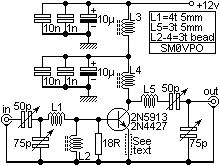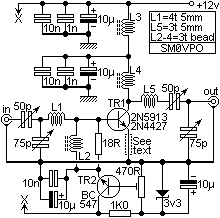

Dedicated to my friend Patrick

Once again my collection of projects creation has been interrupted by another necessity. Patrick and other people have asked me for a circuit of a VHF power amplifier. These circuits are my "standard" building blocks that can be used to amplify RF power signals, from 50MHz to 170MHz, just a few component changes are required. The circuit diagrams shown are "normalised" for 100MHz and will tune about 80MHz through to 120MHz. Simply scale the components up or down if you want to go down or up in frequency bands. The circuits as shown will give a gain of about 14dB with an output power of about 2 Watts (input = 100mW). With an output power of 20 watts the gain falls off to just 12dB at 100MHz or just 10dB at 170MHz.

The first amplifier is efficient but non-linear, so it may ONLY BE USED FOR FM, CW and FSK. It CANNOT be used for "linear" modes of transmission, such as AM or SSB where amplitude conveys information.

L3 is a huge RF choke, made using typically 20 turns of 22SWG wire in a ferrite ring. The wire must be thick enough to carry the PA current. For low powers a small ferrite is more than sufficient. Do NOT scale this inductor for other frequencies.
L4 is made using typically three or four turns of 22SWG enamelled wire inside a two ferrite beads side-by-side, as a pair of biniculars. For higher powers you should ideally use a larger two-hole binocular ferrite core.
L2 is typically four turns of "thin" wire on a single ferrite bead for all frequency bands.
L1 and L5 are both close-wound 22SWG enamelled wire on an air-cored 5mm Dia. former. L1 and L5 should physically be mounted as far away from each other as possible and in a different plane (if one is vertical the other should be horisontal).
The 50pf and 75pf preset caps can be any old caps for low power work, but above about one watt you should select high-power rated components.
The optional resistor in the emitter will restrict the maximum output power by reducing the gain of the whole amplifier. This resistor should be typically 12 ohms for low power devices, such as the 2N3866 or 2N4427 devices. For BLW90 or other high-power devices the emitter resistor should be a total short-circuit. In this event the supply should also be protected with a fuse. In high-power circuits do NOT use relay switching or you will burn out relays. The circuit should not draw any significant current with no signal. The 18 ohm resistor should also be reduced for power devices, typically 5R6 for a 20-watt amplifier.

The above circuit can be made linear so that it can be used to amplify SSB and AM signals. All that is required is to add 0.7vDC of bias to the Base of the amplifying transistor whilst still maintaining the RF Ground at the two DC base feed components.

Here we have added TR2 to provide the 0.7vDC bias in the form of a simple series regulator. For driving small transistors like the 2N3866 and 2N4427, TR2 can be a simple BC547 or a 2N2222. For driving higher power amplifiers you should use a larger transistor fitted with a heatsink. A 2N3053 or BCY51 device should be fine. Before switching on the main DC power to the amplifier, set the bias potentiometer to minumum voltage, apply the power and adjust the pot until TR1 draws a little current. For 500mW to 5 watt devices you should set TR1 current to about 5mA to 50mA. With 5 watt to 25 watt amplifiers you should set the TR1 current to about 50mA to 200mA. Don't be to mean with the standing DC current as it is this that is keeping the FCC of your back by giving you a clean transmission (assuming you have a licence). Now you can align the complete Linear PA.

Tuning up the PA is quite easy, tune the two input caps for maximum supply current. Then tune the two output caps for maximum output power. The two caps are inter-related so you will just have to tune alternately until no further changes are required.
Repeat the tuning again but for maximum output power on both occasions. You should be able to achieve 14dB of gain for 2 watts output power, but a lot depends upon the device you are using. You can use two of these circuits cascaded to give a 20-watt output FM amplifier with only 100mW of drive. The amplifier as shown was first built as a 2-watt amplifier but then extended to give 100 watts using two parallel PA transistors. The drive level was 2.5 watts. 100 watts is not exactly QRP but when you are running your 25mW QRP transmitter it can sometimes be very satisfying to have the power - QRPers are very often stamped on and it can be nice to do a bit of stamping on certain occasions.
Please be aware that even with just 12v (13.8v nominal) and outputs of 20 watts or so, you can still get a nasty RF burn. I have lit cigarettes using the 100 watts version. Also be aware of the supply current. For 100 watts, the supply current was a little over 20 Amperes for the linear version!! You must also use a Low Pass filter between the amplifiers and the antenna, just as you should with any other amplifier.

Have fun with this information. Very best regards from Harry - SM0VPO
Return to INFO page